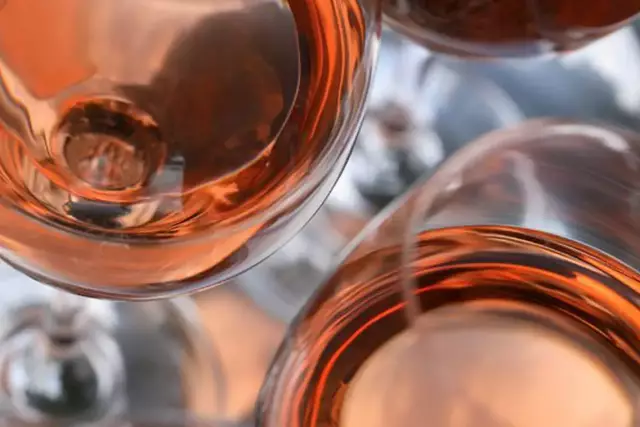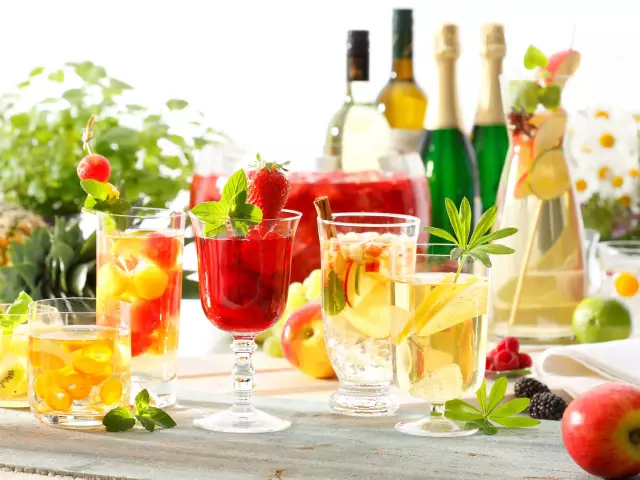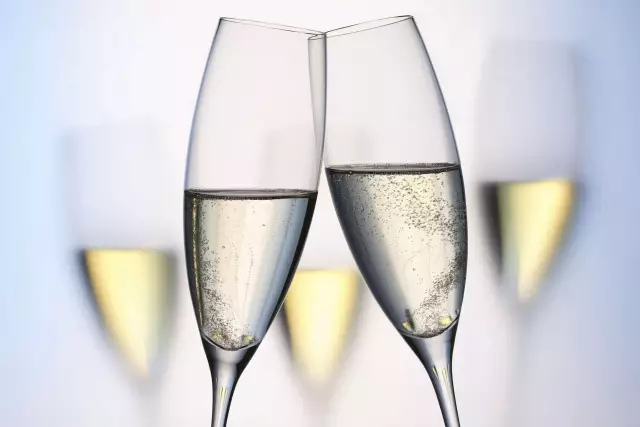Non-alcoholic wines and sparkling wines
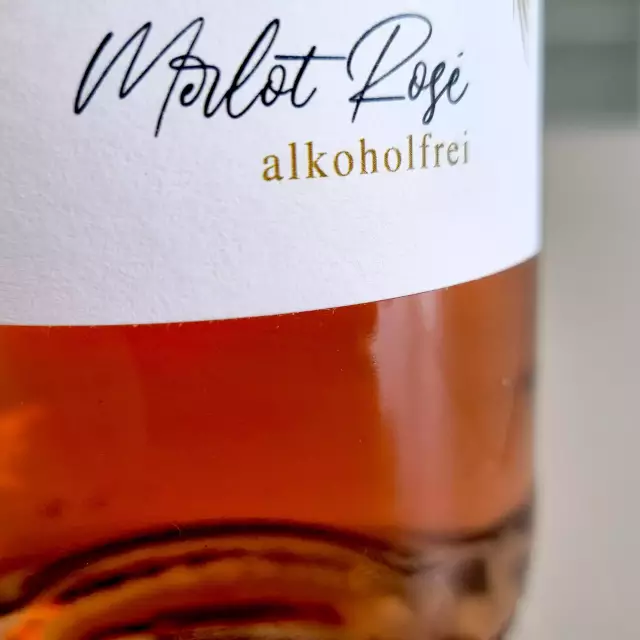
Although they are one of the smallest segments in the wine industry, the demand for dealcoholised wines is growing.
Facts
-
< 1%
Market share
-
15%
Awareness
-
< 0.5 % vol.
Alcohol
The range of dealcoholised wines and sparkling wines from wineries, winegrowers' cooperatives and commercial wineries has increased significantly in recent years. The taste of dealcoholised wines has also developed positively.
Number of producers on the riseA search for wine producers who offer alcohol-free wines, sparkling wines or secco now returns over 60 results (2022).Low level of awareness
Following the trend towards dealcoholised wines and sparkling wines, the market research institute Nielsen conducted a consumer survey on the consumption of dealcoholised wines and sparkling wines in spring 2020. 16,883 respondents from the Nielsen household panel were comparatively unaware that there is also wine without alcohol. Only 15 per cent of respondents were aware of non-alcoholic white wine, twelve per cent of the red and nine per cent of the rose-coloured alternative. Of these groups of people, around a quarter had already drunk the specified non-alcoholic type of wine. The level of awareness of non-alcoholic sparkling wines was significantly higher at 53 per cent. Almost two thirds of people who were familiar with non-alcoholic sparkling wines had already consumed them.Making alcohol-free wines
In order to produce alcohol-free wines, a wine must first be produced from which the alcohol is then removed. This is done by means of vacuum distillation.At a lower pressure, the boiling temperature of the liquid to be separated is reduced to up to 30 degrees so that the alcohol can be gently removed.
Alcohol-free wine therefore undergoes the same development stages as normal wine and still contains many of the original flavourings after alcohol reduction, but only has an alcohol content of 0.5% or less.
How do non-alcoholic wines taste?
According to the Nielsen study, some respondents stated that they were very reserved when it came to non-alcoholic wines, even though they had never consumed the products before. This may well be justified in view of the early production of alcohol-free products. Non-alcoholic wines were produced by removing the alcohol from the wine at elevated temperatures, as a result of which the wine lost a large part of its aromatic diversity. In recent years, non-alcoholic wines have developed significantly in terms of flavour thanks to the new production process. Bouquet varieties such as Sauvignon Blanc or Gewürztraminer are often used as base wines. This gives the end product an intense fruity flavour, which goes some way to compensating for the lack of alcohol. For sparkling wines, carbonic acid is used to compensate for the flavour.
Why more and more consumers are having to give up alcohol
Conscious enjoyment and a balanced lifestyle are much more important today than in the past. The fact that non-alcoholic wines often contain significantly fewer calories also plays an important role in the popularity of non-alcoholic products. So if you want to consciously avoid alcohol, alcohol-free wines and sparkling wines are a good alternative.
Good to know
According to European food law, sparkling wine, wine or beer containing a maximum of 0.5 per cent alcohol by volume (% vol.) may be declared as "alcohol-free". The amount of this percentage of so-called residual alcohol varies from drink to drink.
Podcasts: Non-alcoholic wines and sparkling wines
The DWI podcasts "Alkoholfrei" (Episode 69), Alkoholfeier Wein" (Episode 46) and "Alkoholfreier Schaumwein" (Episode 30) are available on the production of alcohol-free wine products.
What is the market share of dealcoholised sparkling wine ?
The market share of dealcoholised sparkling wine is 5%.
Varietals

with herb crust Roast turkey
with herb crust
- 600 Gramm Putenbrust am Stücke
- 0,25 Liter Weißwein
- 0,25 Liter Gemüsebrühe
- 4 ganze Tomaten
- 4 Scheiben Toastbrot
- 2 ganze Eier
- 2 Stück Zwiebeln
- 75 Gramm geriebener Emmentaler
- 1 Stange Porree
- 1 Bund Schnittlauch
- 1 EL Olivenöl
- nach Belieben Salz & Pfeffer
Wash the meat, pat dry and cut a deep pocket lengthways. Crumble the toast. Wash and chop the herbs, peel and dice the onions.
<p
<p>Preheat the oven to 200°C (top and bottom heat). Place the bread, herbs, onions, cheese and eggs in a bowl, mix thoroughly and season. Stuff 2/3 of this mixture into the turkey breast. Pin the opening with wooden skewers and tie up crosswise with kitchen twine. Place the roast in a roasting tin and brush with oil.
Roast in the preheated oven for approx. 1 hour. Gradually pour in the white wine and vegetable stock.
<p
<p>Clean and wash the vegetables. Cut the leek into pieces and add to the roast with the whole tomatoes after 30 minutes.
About 20 minutes before the end of the cooking time, spread the remaining third of the herb mixture over the roast and finish cooking.
Arrange on plates with the vegetables and serve. Serve with rice.
- Pinot Gris (trocken)
- Chardonnay (trocken)
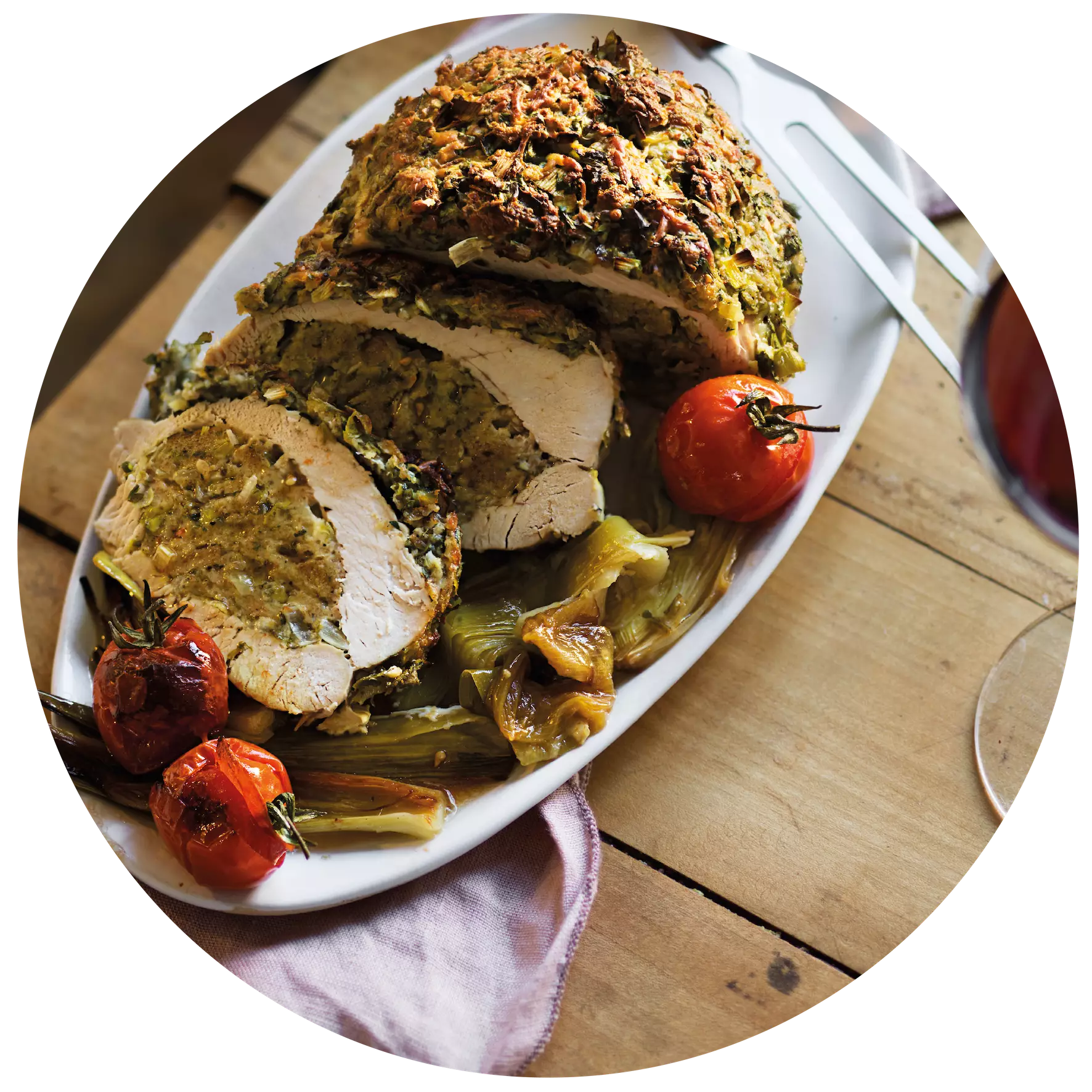
with apples Pork medallions
with apples
- 8 Stück Schweinemedaillons
- 500 Gramm Bandnudeln
- 2 große Äpfel
- 200 ml Sahne
- 10 Blättchen frischer Salbei
- 4 Zweige frischer Thymian
- nach Geschmack Zucker
- 3 EL Calvados
- 1 EL Öl
- zum Abschmecken Salz & Pfeffer
Slightly pepper and salt the medallions on both sides. Pluck the thyme, cut the sage into fine strips and roll the medallions in the herbs. Fry the meat in a pan with a little oil on both sides, not too hot, until it starts to colour. Remove from the pan and place on a preheated tray in the oven at 100 °C until cooked through.
Cook the tagliatelle al dente and keep warm.
In the meantime, peel the apples and cut into slices approx. 1.5 cm wide. Reheat the meat pan and add the apple slices. After about half a minute, sprinkle 1 teaspoon of sugar over the apples and allow them to caramelise. After a minute, deglaze the apple slices with a generous dash of Calvados and flambé. Add the cream and flavour with salt and pepper.
Remove the fillet from the oven. Add the meat juices from the oven dish to the sauce and serve the fillets with the tagliatelle, apple slices and Calvados apple sauce.
<p- Riesling (trocken)
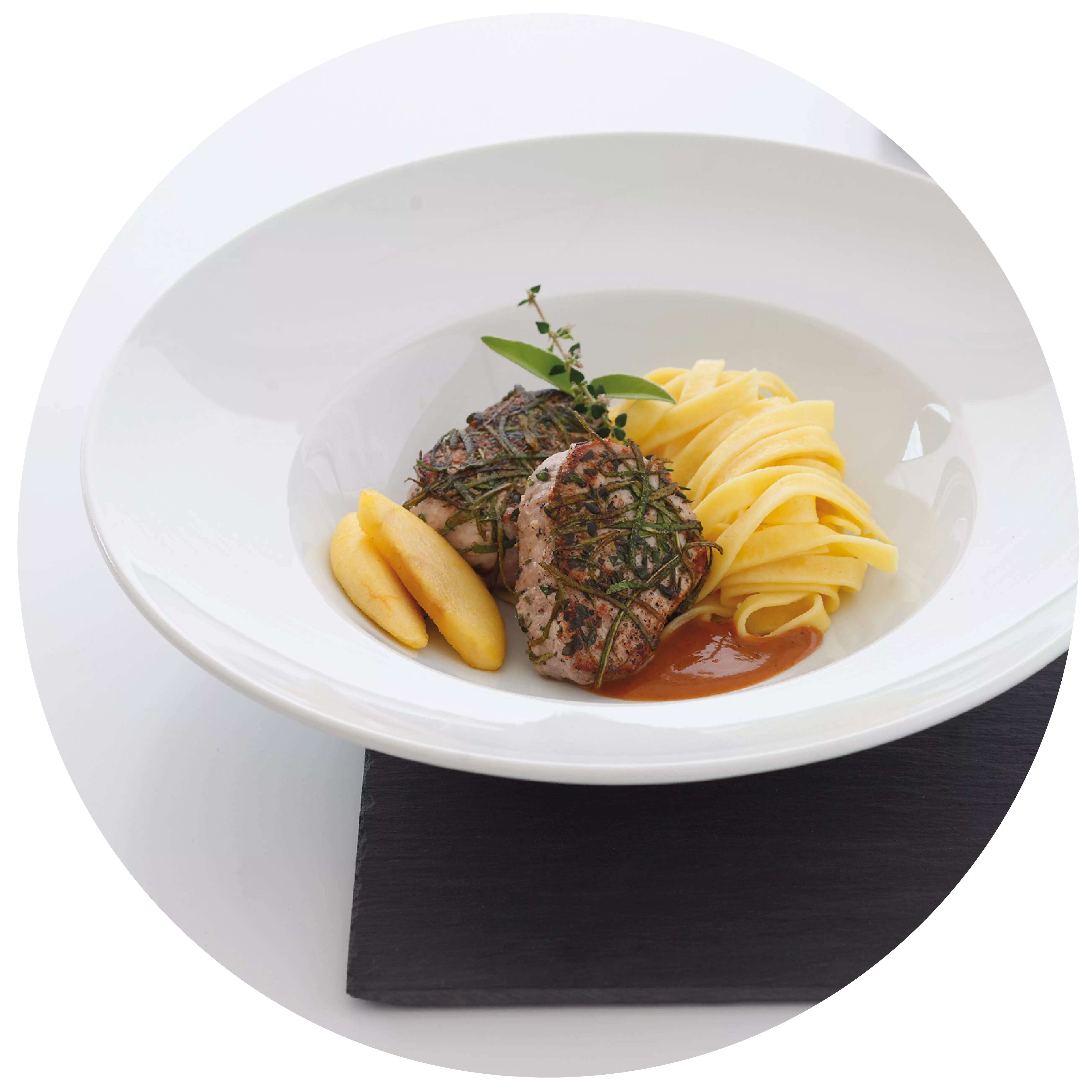
with wild duck breast, porcini mushrooms and glazed chestnuts Herb salad
with wild duck breast, porcini mushrooms and glazed chestnuts
- 150 Gramm Wildkräuter
- 4 EL Olivenöl
- 2 EL Balsamessig
- 8 Stück Wildentenbrüste (a 100g)
- 2 EL Sonnenblumenöl
- 4 EL Honig
- 1 EL Thymian
- 200 Gramm Steinpilze
- 20 gekochte Maronen
- 100 ml Apfelsaft
- 2 El Zucker
- nach Belieben Salz & Pfeffer
Clean, wash and pat dry the wild herbs. Marinate with olive oil and balsamic vinegar and season with salt and pepper.
Preheat the oven to 220°C top and bottom heat. Season the wild duck breasts with salt and pepper, sear on the meat side in a pan with sunflower oil and cook in the preheated oven for about 8 minutes on the skin side. Remove the duck breast, brush the skin side with honey and thyme and roast for another 2 minutes on a high heat until crispy.
Clean the porcini mushrooms and cut into slices. Fry in a pan in oil on both sides, remove and keep warm. Caramelise the sugar in the pan, deglaze with the apple juice and simmer until the caramel has dissolved. Add the chestnuts and add a little more apple juice if necessary.
- Pinot Blanc (trocken)
- Gutedel (trocken)
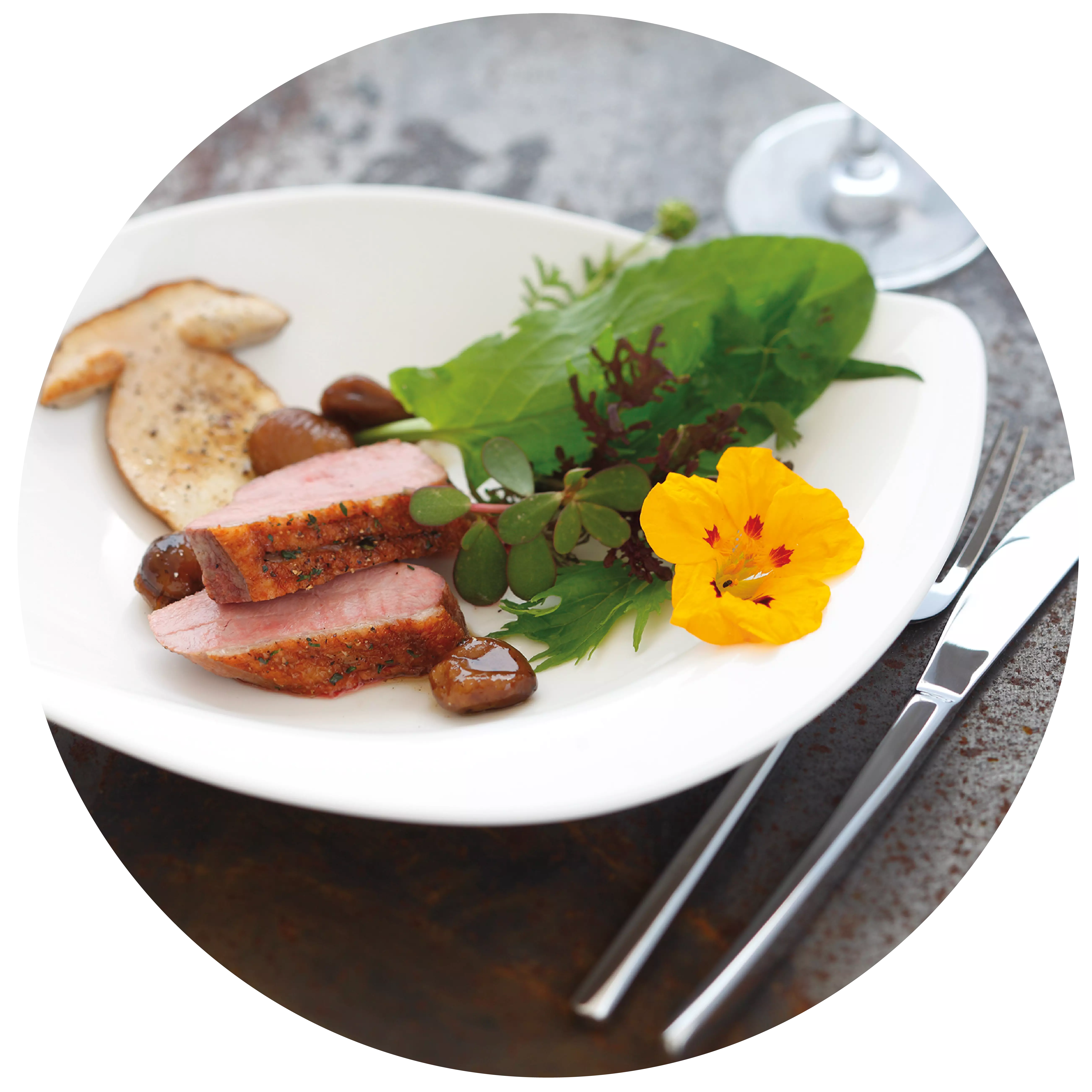
with strong red wine Wild boar ragout
with strong red wine
- 800 Gramm Fleisch vom Wildschwein (Keule o. Schulter)
- 80 Gramm Bauchspeck
- 100 Gramm Zwiebeln
- 60 Gramm Karotten
- 60 Gramm Staudensellerie
- 1 TL Tomatenmark
- 200 ml kräftigen Rotwein
- 100 ml Portwein
- 1 Liter braune Wildbrühe
- 1 TL Preiselbeeren
- 1 EL geschlagene Sahne o. Sauerrahm
- 20 Gramm Mehl
- 1 Stück Lorbeerblatt
- je 1 Zweig Rosmarin und Thymian
- 4 zerdrückte Wacholderbeeren
- 1/2 TL Senf
- nach Belieben Salz & Pfeffer
Clean and wash the vegetables and cut into evenly sized cubes.
Remove the fat, skin and tendons from the wild boar meat and cut into 3 cm cubes. Season with salt and pepper and sprinkle with flour. Heat the oil in a frying pan and brown the meat on all sides. Add the vegetables and diced bacon and fry. Add the tomato purée and stir fry. Deglaze with the red wine and port, reduce and pour in the brown game stock. Add the spices to the meat in a small spice bag and leave the ragout to simmer in the oven at 160°C for approx. 1½ hours.
Then remove the pieces of meat, remove the spices, strain the sauce, add the cranberries and mustard and leave to reduce for about 15 minutes. If necessary, thicken with a little cornflour. Serve with the whipped cream.
- Spätburgunder / Pinot Noir (trocken)
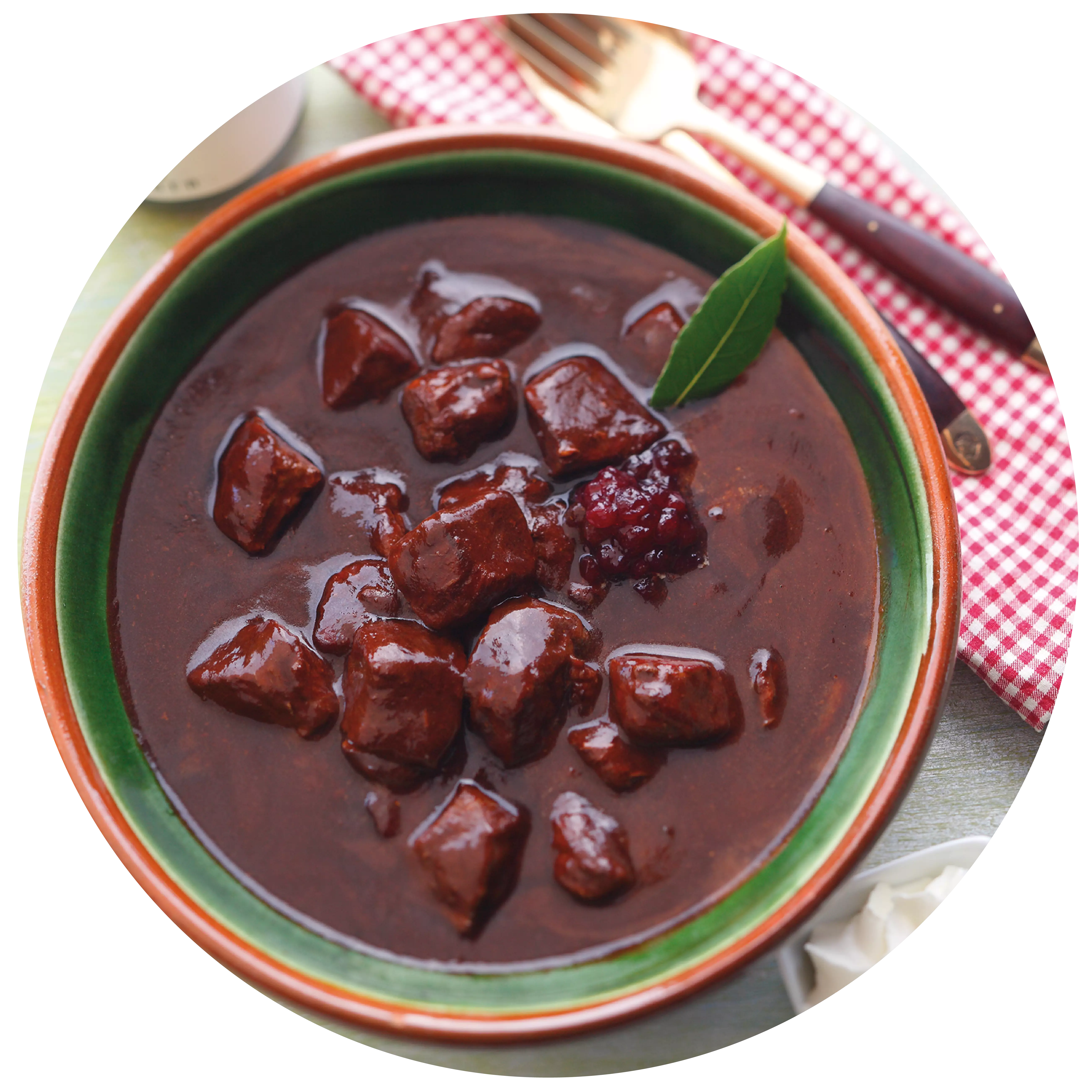
Teaser
Events
-
Show
winetasting in our winery - cheese & wine
Mainz-Hechtsheim


